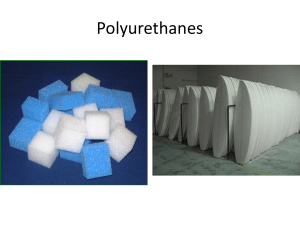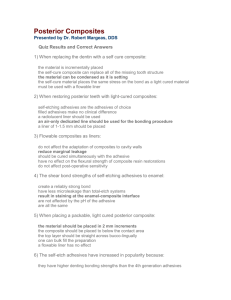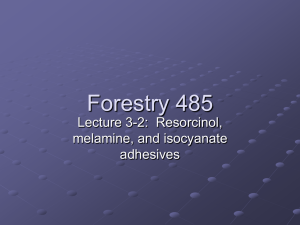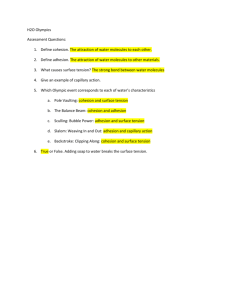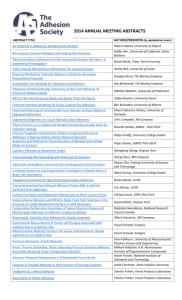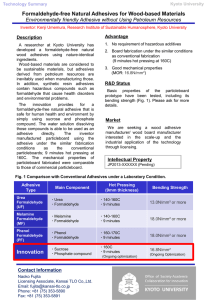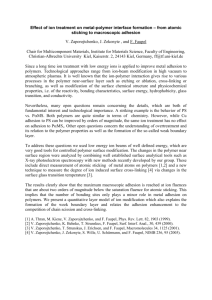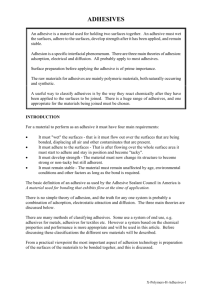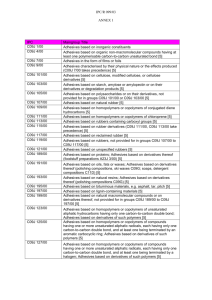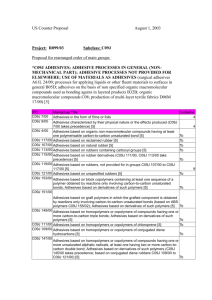Society for Adhesion and Adhesives One day meeting Polyurethane
advertisement
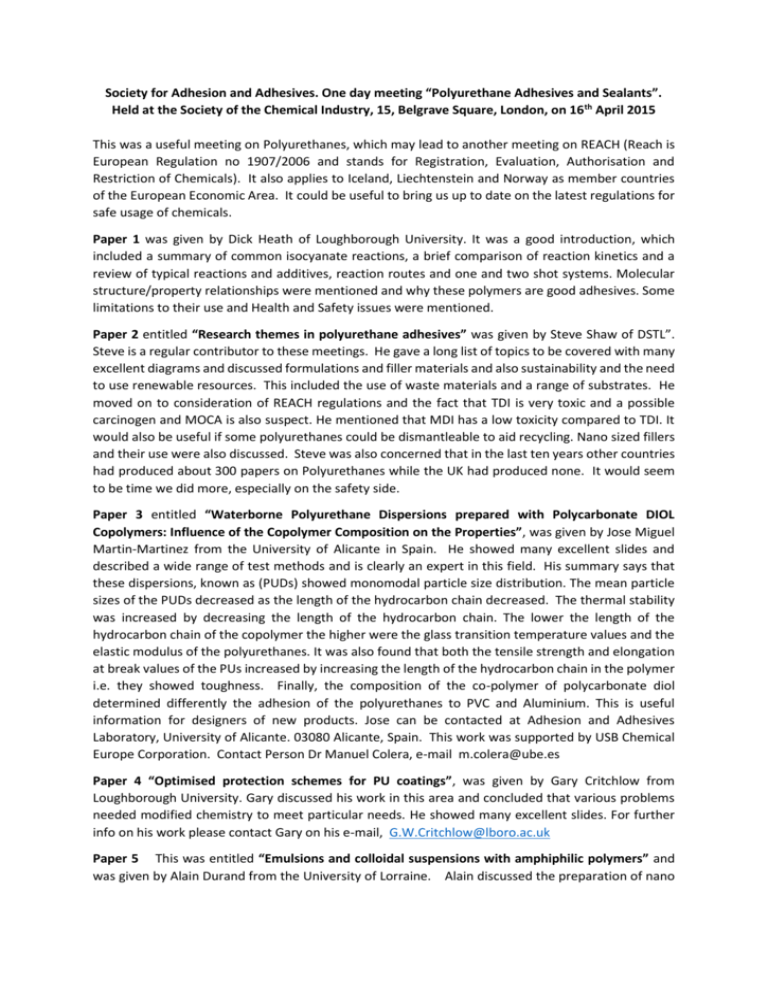
Society for Adhesion and Adhesives. One day meeting “Polyurethane Adhesives and Sealants”. Held at the Society of the Chemical Industry, 15, Belgrave Square, London, on 16th April 2015 This was a useful meeting on Polyurethanes, which may lead to another meeting on REACH (Reach is European Regulation no 1907/2006 and stands for Registration, Evaluation, Authorisation and Restriction of Chemicals). It also applies to Iceland, Liechtenstein and Norway as member countries of the European Economic Area. It could be useful to bring us up to date on the latest regulations for safe usage of chemicals. Paper 1 was given by Dick Heath of Loughborough University. It was a good introduction, which included a summary of common isocyanate reactions, a brief comparison of reaction kinetics and a review of typical reactions and additives, reaction routes and one and two shot systems. Molecular structure/property relationships were mentioned and why these polymers are good adhesives. Some limitations to their use and Health and Safety issues were mentioned. Paper 2 entitled “Research themes in polyurethane adhesives” was given by Steve Shaw of DSTL”. Steve is a regular contributor to these meetings. He gave a long list of topics to be covered with many excellent diagrams and discussed formulations and filler materials and also sustainability and the need to use renewable resources. This included the use of waste materials and a range of substrates. He moved on to consideration of REACH regulations and the fact that TDI is very toxic and a possible carcinogen and MOCA is also suspect. He mentioned that MDI has a low toxicity compared to TDI. It would also be useful if some polyurethanes could be dismantleable to aid recycling. Nano sized fillers and their use were also discussed. Steve was also concerned that in the last ten years other countries had produced about 300 papers on Polyurethanes while the UK had produced none. It would seem to be time we did more, especially on the safety side. Paper 3 entitled “Waterborne Polyurethane Dispersions prepared with Polycarbonate DIOL Copolymers: Influence of the Copolymer Composition on the Properties”, was given by Jose Miguel Martin-Martinez from the University of Alicante in Spain. He showed many excellent slides and described a wide range of test methods and is clearly an expert in this field. His summary says that these dispersions, known as (PUDs) showed monomodal particle size distribution. The mean particle sizes of the PUDs decreased as the length of the hydrocarbon chain decreased. The thermal stability was increased by decreasing the length of the hydrocarbon chain. The lower the length of the hydrocarbon chain of the copolymer the higher were the glass transition temperature values and the elastic modulus of the polyurethanes. It was also found that both the tensile strength and elongation at break values of the PUs increased by increasing the length of the hydrocarbon chain in the polymer i.e. they showed toughness. Finally, the composition of the co-polymer of polycarbonate diol determined differently the adhesion of the polyurethanes to PVC and Aluminium. This is useful information for designers of new products. Jose can be contacted at Adhesion and Adhesives Laboratory, University of Alicante. 03080 Alicante, Spain. This work was supported by USB Chemical Europe Corporation. Contact Person Dr Manuel Colera, e-mail m.colera@ube.es Paper 4 “Optimised protection schemes for PU coatings”, was given by Gary Critchlow from Loughborough University. Gary discussed his work in this area and concluded that various problems needed modified chemistry to meet particular needs. He showed many excellent slides. For further info on his work please contact Gary on his e-mail, G.W.Critchlow@lboro.ac.uk Paper 5 This was entitled “Emulsions and colloidal suspensions with amphiphilic polymers” and was given by Alain Durand from the University of Lorraine. Alain discussed the preparation of nano particles and emulsion polymerisation in great detail but no paper was supplied. It was an excellent paper. For a copy or further details please contact Alain at the University of Lorraine. Paper 6. “A Study of Interfacial Interaction between Methylene Diphenyl Diisocyanate (MDI) and Metals” was given by Sabrina Tardio, Department of Mechanical Engineering Sciences, University of Surrey, Guildford, Surrey, GU2-7XH, UK. Contact s.tardio@surrey.ac.uk. In her introduction Sabrina reminded us that polyurethanes are widely used as adhesives in industry because they show excellent adhesion to oxidised metal surfaces. Often adhesion is the result of intermolecular forces between adherent and substrate. The understanding of adhesion phenomena is nowadays investigated by characterisation of the interfacial interactions that occur when the adhesive or coating is applied to the substrate. The PU polymer chain is formed of urethane linkages. This bond is the product of the reaction between a hydroxyl group and an isocyanate. The great majority of di-isocyanate used in the poly-addition reaction is methylene di-phenyl di-isocyanate (MDI). Fortunately MDI has a lower toxicity than some other isocyanates so it is well worth this very detailed investigation. According to Figure 2 both Water exposed and Air exposed samples reached the same Nitrogen concentration at the maximum Solution concentration used. This is a very detailed paper best read by a highly mathematical Chemist. It should prove very useful as Stainless steel is one of the more difficult materials when trying to achieve strong and durable bonds. Paper 7 on “Moisture curing Isocyanates “ was given by John Comyn, also from Loughborough and a regular contributor to these meetings. This paper needs to be read in full as it contains a considerable amount of information. After a detailed introduction John described a particular project to study two hot melt adhesives made by National Starch. These were Type 69 and Type 254. They were studied in great detail and showed the very considerable effort that goes into designing and manufacturing new products to meet particular needs. Contact John Comyn e-mail (please add this) This was another useful meeting of the SAA. Details of further symposia can be obtained from D A Tod QinetiQ X50 Fort Halstead Sevenoaks Kent TN 14-7BP
